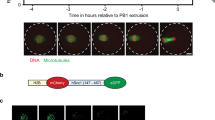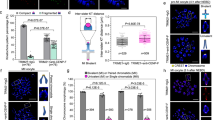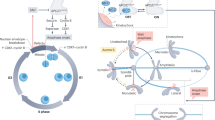Abstract
Since the discovery of cytostatic factor (CSF) 35 years ago, significant progress has been made in identifying molecular components of CSF activity and the mechanism of CSF-induced metaphase II arrest (CSF arrest). This short review focuses on recent discoveries in the field and discusses the implication of these results for a general picture of CSF establishment and release. One recent focus is on the cyclin E/Cdk2 pathway. The discovery of a downstream target for cyclin E/Cdk2, the spindle checkpoint protein Mps1, provides insight into how cyclin E/Cdk2 contributes to CSF arrest. The anaphase promoting complex/cyclosome (APC/C) inhibitor Emi2 is another recent focus of work in the field. It is now clear that not only is degradation of Emi2 critical for CSF release, but its abrupt accumulation during meiosis II (M II) is also required for the establishment of CSF arrest. Thus, by discrete pathways of APC/C inhibition operative during CSF arrest, the stability of cell cycle arrest in the egg appears to be reinforced by multiple mechanisms.
This is a preview of subscription content, access via your institution
Access options
Subscribe to this journal
Receive 50 print issues and online access
$259.00 per year
only $5.18 per issue
Buy this article
- Purchase on Springer Link
- Instant access to full article PDF
Prices may be subject to local taxes which are calculated during checkout

Similar content being viewed by others
References
Abrieu A, Magnaghi-Jaulin L, Kahana JA, Peter M, Castro A, Vigneron S et al. (2001). Mps1 is a kinetochore-associated kinase essential for the vertebrate mitotic checkpoint. Cell 106: 83–93.
Bhatt RR, Ferrell Jr JE . (1999). The protein kinase p90 rsk as an essential mediator of cytostatic factor activity. Science 286: 1362–1365.
D'Angiolella V, Costanzo V, Gottesman ME, Avvedimento EV, Gautier J, Grieco D . (2001). Role for cyclin-dependent kinase 2 in mitosis exit. Curr Biol 11: 1221–1226.
Fisk HA, Winey M . (2001). The mouse Mps1p-like kinase regulates centrosome duplication. Cell 106: 95–104.
Grimison B, Liu J, Lewellyn AL, Maller JL . (2006). Metaphase arrest by cyclin E/Cdk2 requires the spindle checkpoint kinase Mps 1. Curr Biol 16: 1968–1973.
Hansen DV, Tung JJ, Jackson PK . (2006). CaMKII and polo-like kinase 1 sequentially phosphorylate the cytostatic factor Emi2/XErp1 to trigger its destruction and meiotic exit. Proc Natl Acad Sci USA 103: 608–613.
Liu J, Grimison B, Lewellyn AL, Maller JL . (2006). The APC/C inhibitor Emi2 is essential for meiotic but not mitotic cell cycles. J Biol Chem 281: 34736–34741.
Liu J, Maller JL . (2005). Calcium elevation at fertilization coordinates phosphorylation of XErp1/Emi2 by Plx1 and CaMK II to release metaphase arrest by cytostatic factor. Curr Biol 15: 1458–1468.
Lorca T, Cruzalegui FH, Fesquet D, Cavadore JC, Mery J, Means A et al. (1993). Calmodulin-dependent protein kinase II mediates inactivation of MPF and CSF upon fertilization of Xenopus eggs. Nature 366: 270–273.
Madgwick S, Hansen DV, Levasseur M, Jackson PK, Jones KT . (2006). Mouse Emi2 is required to enter meiosis II by reestablishing cyclin B1 during interkinesis. J Cell Biol 174: 791–801.
Masui Y, Markert CL . (1971). Cytoplasmic control of nuclear behavior during meiotic maturation of frog oocytes. J Exp Zool 177: 129–145.
Ohsumi K, Koyanagi A, Yamamoto TM, Gotoh T, Kishimoto T . (2004). Emi1-mediated M-phase arrest in Xenopus eggs is distinct from cytostatic factor arrest. Proc Natl Acad Sci USA 101: 12531–12536.
Phillips KP, Petrunewich MA, Collins JL, Booth RA, Liu XJ, Baltz JM . (2002). Inhibition of MEK or cdc2 kinase parthenogenetically activates mouse eggs and yields the same phenotypes as Mos(−/−) parthenogenotes. Dev Biol 247: 210–223.
Rauh NR, Schmidt A, Bormann J, Nigg EA, Mayer TU . (2005). Calcium triggers exit from meiosis II by targeting the APC/C inhibitor XErp1 for degradation. Nature 437: 1048–1052.
Reimann JD, Jackson PK . (2002). Emi1 is required for cytostatic factor arrest in vertebrate eggs. Nature 416: 850–854.
Rempel RE, Sleight SB, Maller JL . (1995). Maternal Xenopus Cdk2–cyclin E complexes function during meiotic and early embryonic cell cycles that lack a G1 phase. J Biol Chem 270: 6843–6855.
Roy LM, Haccard O, Izumi T, Lattes BG, Lewellyn AL, Maller JL . (1996). Mos proto-oncogene function during oocyte maturation in Xenopus. Oncogene 12: 2203–2211.
Sagata N, Watanabe N, Vande Woude GF, Ikawa Y . (1989). The c-mos proto-oncogene product is a cytostatic factor responsible for meiotic arrest in vertebrate eggs. Nature 342: 512–518.
Schmidt A, Duncan PI, Rauh NR, Sauer G, Fry AM, Nigg EA et al. (2005). Xenopus polo-like kinase Plx1 regulates XErp1, a novel inhibitor of APC/C activity. Genes Dev 19: 502–513.
Schmidt A, Rauh NR, Nigg EA, Mayer TU . (2006). Cytostatic factor: an activity that puts the cell cycle on hold. J Cell Sci 119(Part 7): 1213–1218.
Sharp-Baker H, Chen RH . (2001). Spindle checkpoint protein Bub1 is required for kinetochore localization of Mad1, Mad2, Bub3, and CENP-E, independently of its kinase activity. J Cell Biol 153: 1239–1250.
Shoji S, Yoshida N, Amanai M, Ohgishi M, Fukui T, Fujimoto S et al (2006). Mammalian Emi2 mediates cytostatic arrest and transduces the signal for meiotic exit via Cdc20. EMBO J 25: 834–845.
Tung JJ, Hansen DV, Ban KH, Loktev AV, Summers MK, Adler III JR et al (2005). A role for the anaphase-promoting complex inhibitor Emi2/XErp1, a homolog of early mitotic inhibitor 1, in cytostatic factor arrest of Xenopus eggs. Proc Natl Acad Sci USA 102: 4318–4323.
Tunquist BJ, Eyers PA, Chen LG, Lewellyn AL, Maller JL . (2003). Spindle checkpoint proteins Mad1 and Mad2 are required for cytostatic factor-mediated metaphase arrest. J Cell Biol 163: 1231–1242.
Tunquist BJ, Maller JL . (2003). Under arrest: cytostatic factor (CSF)-mediated metaphase arrest in vertebrate eggs. Genes Dev 17: 683–710.
Tunquist BJ, Schwab MS, Chen LG, Maller JL . (2002). The spindle checkpoint kinase bub1 and cyclin e/cdk2 both contribute to the establishment of meiotic metaphase arrest by cytostatic factor. Curr Biol 12: 1027–1033.
Watanabe N, Hunt T, Ikawa Y, Sagata N . (1991). Independent inactivation of MPF and cytostatic factor (Mos) upon fertilization of Xenopus eggs. Nature 352: 247–248.
Author information
Authors and Affiliations
Corresponding author
Rights and permissions
About this article
Cite this article
Liu, J., Grimison, B. & Maller, J. New insight into metaphase arrest by cytostatic factor: from establishment to release. Oncogene 26, 1286–1289 (2007). https://doi.org/10.1038/sj.onc.1210203
Published:
Issue Date:
DOI: https://doi.org/10.1038/sj.onc.1210203
Keywords
This article is cited by
-
Structural basis for recognition of Emi2 by Polo-like kinase 1 and development of peptidomimetics blocking oocyte maturation and fertilization
Scientific Reports (2015)
-
A deadenylation negative feedback mechanism governs meiotic metaphase arrest
Nature (2008)
-
Calcineurin is required to release Xenopus egg extracts from meiotic M phase
Nature (2007)



